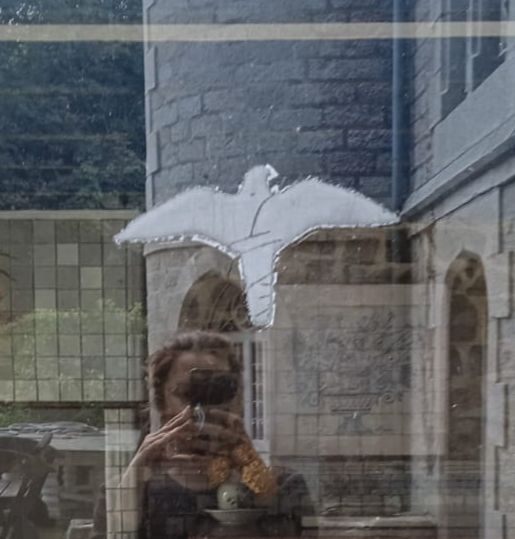Vous êtes ici :
- Unité de recherche
- CY Héritages
- Accueil
- L'UMR
- Équipe
- Doctorant.es
Apolline Debussan (Apolline Brechotteau)

Compte Instagram : https://www.instagram.com/apollinedebussan/
CV d'Apolline Debussan
Date d'inscription
Septembre 2018
Directeurs de recherche
Chantal Lapeyre et Emmanuel Moses
Intitulé de la thèse
FAIRE CORPS : Essai sur le fantôme contemporain
Résumé de la thèse
Des traces d’un corps qui n’est plus aujourd’hui – non pas mort, mais invisible sous nos yeux. Disparu, parfois seulement caché – derrière une porte, à l’ombre d’un souvenir –, comprendre ce qu’est l’autre, c’est comprendre ce que l’on est. Il faut tenter d’écrire le fantôme, d’intercepter par l’écriture ce vacillement qui donne l’illusion de la matière pour rendre compte de ce qui nous unit. Et de là démarre le grand voyage, non pas celui qui mène vers la mort, mais celui qui nous commande d’écrire l’absence de corps et de donner une alternative au corps suspendu du fantôme. Retrouver sa forme, lui rendre ses contours, enquêter sur ce corps de souvenir, lui donner corps.Qui sont ces remembrants, aimables fantômes issus de souvenirs et dont les écrivains recherchent volontiers la compagnie ? Le fantôme investit la littérature contemporaine sous la forme d'un souvenir hantant, mettant de côté la question de la croyance et du fantastique. Détaché de sa teinte spirituelle, le fantôme est une création imaginaire. Il est une force insistante qui prend ancrage dans les traces laissées par les disparus et pousse les écrivains à mener une enquête. De cette enquête fantomale naît une tentative de faire corps au fantôme par la multiplication des représentations du disparu, l'association à d'autres figures et la matérialisation de traces documentaires, véritables matières du fantôme. Tout comme le remembrant, l'enquête fantomale se fait revenante, dévoilant par cette succession d'enquêtes, une tendance à l'écriture en série. Quand l'enquête ne revient pas, ce sont les images du fantôme qui reviennent, nous confrontant à une nouvelle apparition des disparus. Cette revenance rend compte de la contemporanéité du fantôme et questionne l'espace dans lequel il apparaît. Le fantôme n'est-il chez lui qu'à l'intérieur du texte ? Son cœur, puissamment littéraire, peut-il l'amener à s'exposer, à se performer et s'incarner dans un ailleurs extratextuel, profitant de l'invitation pour surgir dans nos vies ? Par la pratique et par la recherche théorique, Apolline Debussan interroge la forme prise par le fantôme dans l'enquête fantomale ainsi que l'usage des ressources documentaires auxquelles les écrivains et elle-même ont recours pour l'incarner. L'union de ces deux recherches – forme et matière – dévoilera les coulisses d'une fabrique du fantôme.
Résumé de la thèse en anglais
Traces of a body that is no longer there - not dead, but invisible before our eyes. Vanished, sometimes only hidden - behind a door, in the shadow of a memory - to understand what the other is is to understand what we are. We must try to write the ghost, to intercept through our writing the flickering that gives the illusion of matter, to give an account of what unites us. And from there begins the great journey, not the one that leads to death, but the one that commands us to write the absence of a body and to give an alternative to the suspended body of the ghost. To rediscover its shape, to give it back its contours, to investigate this body of memory, to give it body.Who are these remembrancers, the friendly ghosts of memories whose company writers seek out? The ghost has taken over contemporary literature in the form of a haunting memory, putting aside the question of belief and fantasy. Detached from its spiritual tinge, the ghost is an imaginary creation. It is an insistent force that takes root in the traces left by the disappeared and prompts writers to investigate. This ghostly investigation gives rise to an attempt to give substance to the ghost through the multiplication of representations of the disappeared, the association with other figures and the materialisation of documentary traces, the real material of the ghost. Like the remembrant, the ghostly investigation becomes a revenant, revealing, through this succession of investigations, a tendency towards serial writing. When the investigation does not return, it is the images of the ghost that come back, confronting us with a new apparition of the disappeared. This return reflects the contemporary nature of the ghost and questions the space in which it appears. Is the ghost at home only within the text? Can its powerfully literary heart lead it to expose itself, to perform and embody itself in an extratextual elsewhere, taking advantage of the invitation to appear in our lives? Through practice and theoretical research, Apolline Debussan examines the form taken by the ghost in ghost investigation, and the use of documentary resources that she and other writers use to embody it. Combining these two areas of research - form and material - will reveal the behind-the-scenes workings of a ghost factory.



